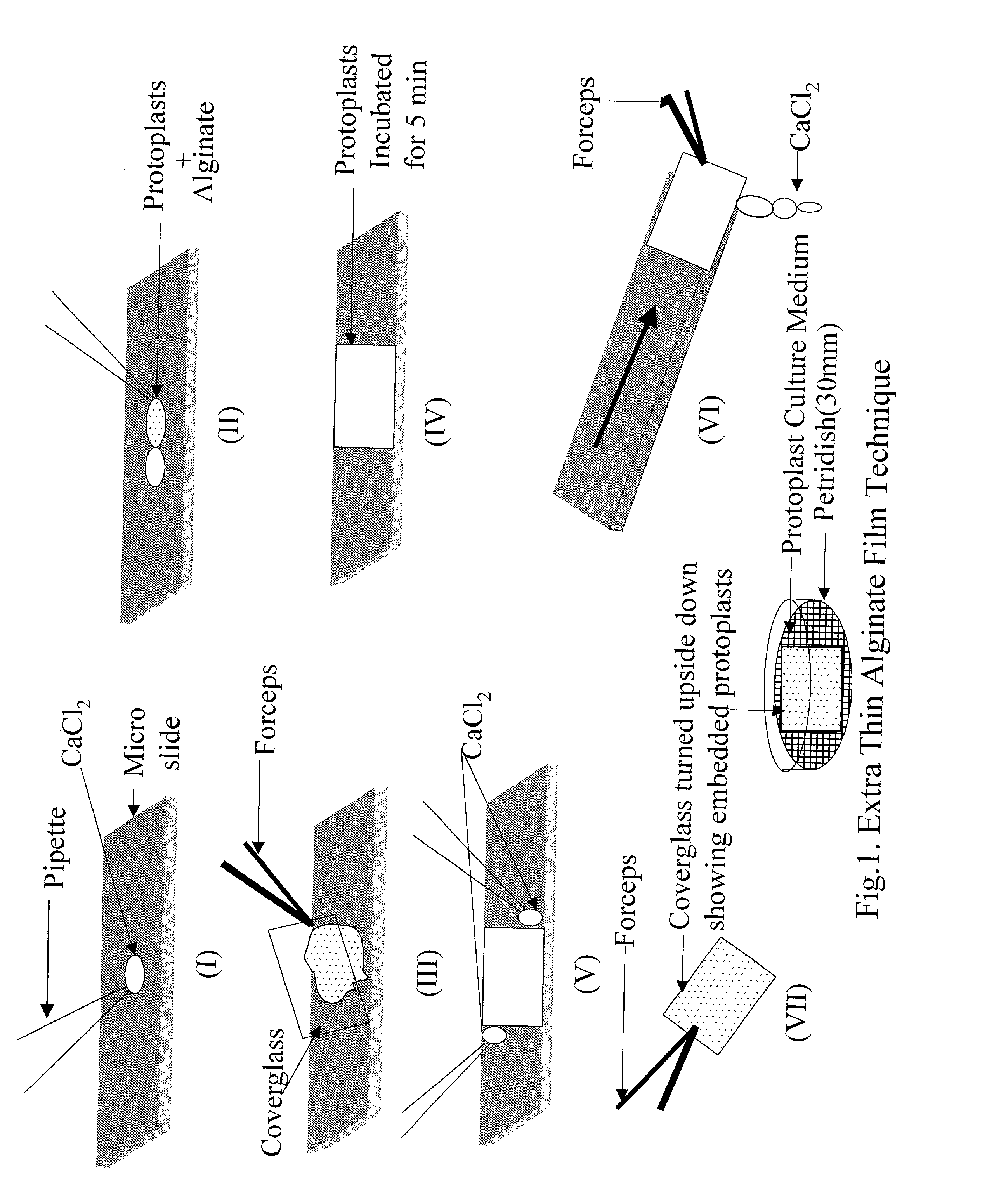Efficient method of protoplast culture
a protoplast and culture method technology, applied in the field of protoplast culture efficiency, can solve the problems of no standard methods for the isolation and culture of protoplasts, adversely affecting the dividing protoplasts, and requiring a relatively large volume of protoplast suspension, so as to improve the universal appeal, facilitate observation and tracking, and simplify the procedure
- Summary
- Abstract
- Description
- Claims
- Application Information
AI Technical Summary
Benefits of technology
Problems solved by technology
Method used
Image
Examples
example-1
[0055] In rose, protoplasts were isolated from actively growing cell suspension in exponential phase (7-8 days after subculture) in fresh Murashige and Skoog (MS) medium (Murashige T. and Skoog F. 1962. A revised medium for rapid growth and bioassays with tobacco tissue cultures. Physiologia Plantarum 15: 473-497) containing 6-benzylamino purine (BAP) and 2,4-dichlorophenoxy acetic acid (2,4-D) (5 .mu.M each). The cell culture medium was decanted and the cells plasmolysed in a plasmolysing solution i.e., CPW 13M (Cell and Protoplast Washing salt solution with 13% mannitol) for one hour. Later on, CPW was replaced by an enzyme mixture (Cellulase R10, Onozuka, Yakult Honsha, Japan, 1.0-5.0%; Macerozyme R10, Onozuka, Yakult Honsha, Japan, 0.25-1.0%; and Driselase (Sigma, USA, 0.25-1.0%) and incubated at 25.degree. C. in dark on a shaker (60 rpm) for 14-16 hours. After incubation, protoplasts and partly digested cells were passed through a sieve (90 .mu.m pore size) with undigested tiss...
example-2
[0056] Seeds of Nicotiana tobacum cv. Petit Havana were soaked in water for 2 hours. These were surface sterilized in 2.0% (w / v) calcium hypochlorite solution for 20-25 minutes and repeatedly washed in sterilized distilled water in order to remove the traces of sterilizing agent. These were inoculated in 100 ml Erlenmeyer flasks containing MS medium+sucrose 2.0%+agar 0.8%. After about a week, the roots of seedlings were excised and shoots were transferred one each in bigger culture vessels. Fully expanded leaves (3rd or 4th) from these cultures were taken for protoplast isolation. A leaf was placed on a ceramic tile with its abaxial side up. After having removed the midrib, either epidermis was peeled off or the leaf sliced into small pieces. These leaf pieces (abaxial side down) were transferred to a petridish containing 9 ml of protoplast isolation medium and 0.5 ml each of cellulase R10 and macerozyme 1% enzyme stock solution in sucrose. The dishes were sealed and incubated overn...
example-3
[0057] Seeds of Lotus corniculatus were surface sterilized using 0.04% (v / v) sodium hypochlorite containing 0.2% (v / v) tween 80 (Himedia, Mumbai) for 20 minutes on a gyratory shaker. The solution was decanted and next step of surface sterilization was carried out in a laminar flow cabinet using 0.04% (w / v) mercuric chloride solution to which 1-2 drops of Tween 80 were added as a wetting agent. After 6-7 minutes, the mercuric chloride solution was decanted and seeds repeatedly washed with sterilized distilled water to remove all traces of sterilizing agent. Seeds were germinated on agar (0.8%) gelled Murashige and Skoog (1962) medium containing 3% sucrose but lacking growth regulators, and incubated in the dark at 23.+-.2.degree. C. Cotyledons were excised from 2-7 days old aseptic seedlings maintained at 4.degree. C. for 48 hours in the dark prior to use. The cotyledon slices were chopped into small pieces and put in a plasmolytic solution i.e. CPW 13M for one hour which was later r...
PUM
 Login to View More
Login to View More Abstract
Description
Claims
Application Information
 Login to View More
Login to View More - R&D
- Intellectual Property
- Life Sciences
- Materials
- Tech Scout
- Unparalleled Data Quality
- Higher Quality Content
- 60% Fewer Hallucinations
Browse by: Latest US Patents, China's latest patents, Technical Efficacy Thesaurus, Application Domain, Technology Topic, Popular Technical Reports.
© 2025 PatSnap. All rights reserved.Legal|Privacy policy|Modern Slavery Act Transparency Statement|Sitemap|About US| Contact US: help@patsnap.com

